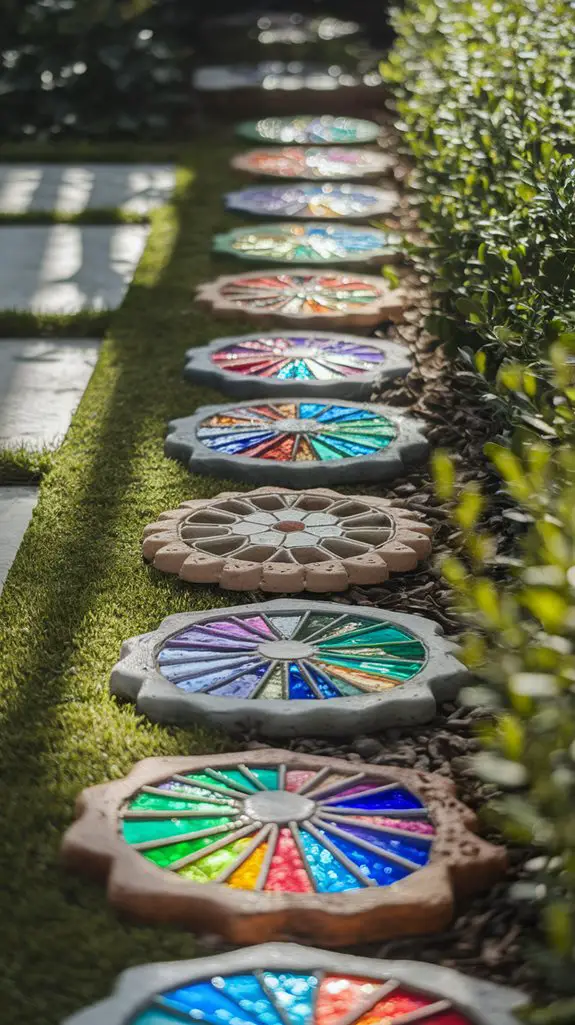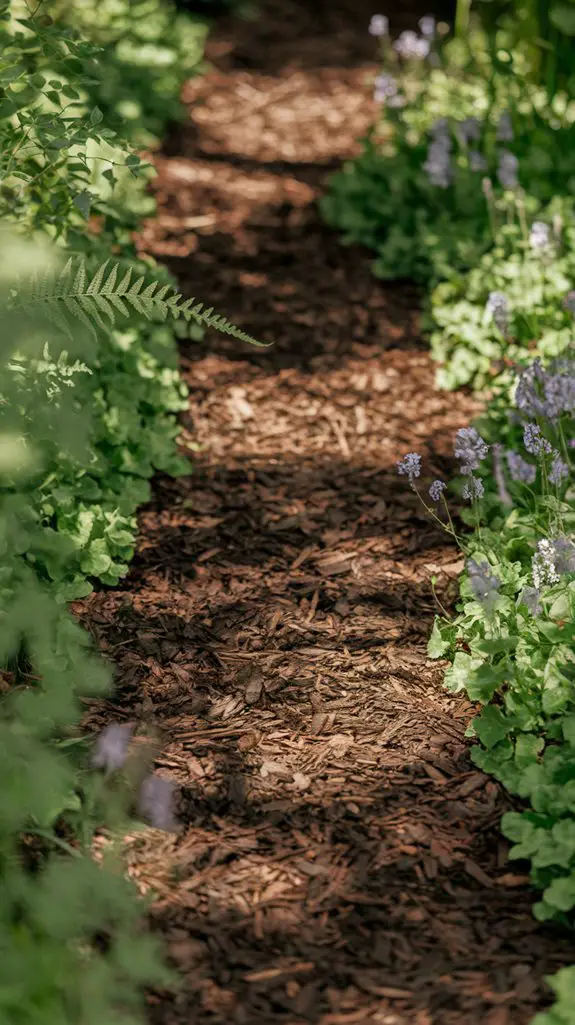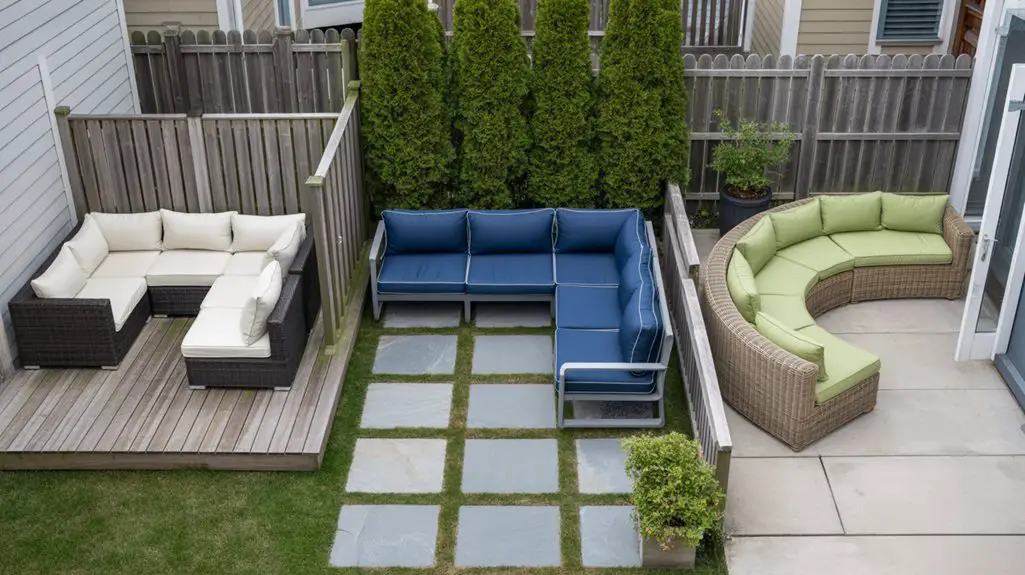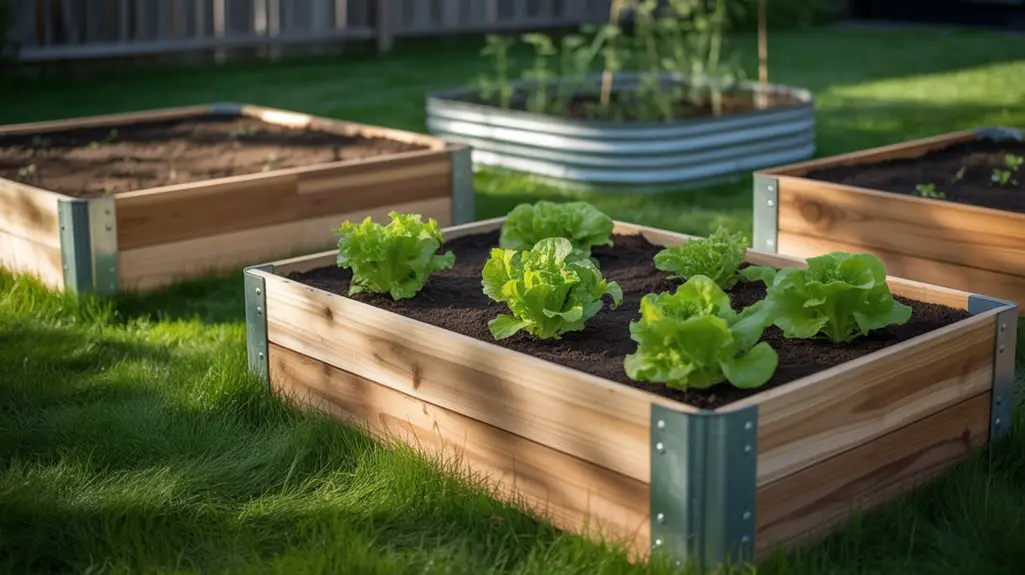Did you know that 78% of homeowners prioritize outdoor improvements that balance aesthetics with affordability? Your backyard pathways don’t need to drain your wallet to transform your garden’s appeal and functionality. With strategic material choices and simple DIY techniques, you can create inviting walkways that complement your landscape design while keeping costs manageable. The secret lies in knowing which affordable options deliver the most visual impact for your investment.
Gravel and Stone Pathways for Cost-Effective Charm
When creating an affordable outdoor oasis, gravel and stone pathways stand as the quintessential budget-friendly solution for connecting garden spaces.
These versatile materials offer both practicality and aesthetic appeal while costing greatly less than concrete or pavers.
Opt for locally sourced gravel like pea gravel ($30-$50 per ton) or crushed granite to minimize delivery expenses. For a more structured look, edge your path with reclaimed brick, natural stone, or pressure-treated lumber.
Installing a proper foundation is essential—excavate to 3-4 inches, lay landscape fabric to prevent weed growth, then add your chosen stone material.
For enhanced stability, consider step stones placed strategically throughout gravel sections, creating a hybrid path that remains navigable in all weather conditions while maintaining its budget-friendly charm. Additionally, using affordable garden materials can further enhance the overall look and feel of your outdoor space without breaking the bank.
DIY Stepping Stones From Repurposed Materials

For an even more economical approach than gravel pathways, creating your own stepping stones from repurposed materials represents the pinnacle of budget-conscious garden design. You’ll find endless possibilities by reimagining everyday items as pathway elements.
| Material | Cost | Durability |
|---|---|---|
| Broken concrete | Free | Excellent |
| Wooden rounds | $0-10 | 3-5 years |
| Hypertufa mix | $15-20 | Decades |
Collect broken concrete slabs (urbanite) from demolition projects, slice fallen tree limbs into rounds, or craft hypertufa stones using a 1:1:1 ratio of Portland cement, peat moss, and perlite. Consider embedding decorative elements like sea glass, marbles, or mosaic pieces into wet cement for personalized touches that elevate your pathway from purely functional to artistic expression. Additionally, using the right materials for your garden beds can enhance the overall aesthetic and functionality of your outdoor space.
Mulch Paths: Natural and Inexpensive Solutions

Among the most accessible path materials available, mulch offers an organic aesthetic that seamlessly integrates into garden landscapes while maintaining a remarkably low price point.
Hardwood varieties like cedar and cypress provide durability, naturally repel insects, and break down slowly—making them ideal for high-traffic areas.
Consider creating defined edges with pressure-treated lumber or recycled plastic edging to prevent migration. A 2-3 inch depth guarantees proper weed suppression while allowing for adequate drainage.
For best results, install landscape fabric underneath to minimize maintenance and extend your path’s lifespan.
Pine needle mulch (pine straw) offers an alternative texture with excellent drainage properties, particularly suited for shaded areas. Additionally, using eco-friendly materials can further enhance the sustainability of your garden path.
Refresh your mulch path annually with a thin new layer to maintain its appearance and functionality without complete replacement.
Pallet Wood Walkways on a Shoestring Budget
Repurposed pallet wood presents another eco-friendly path solution that costs virtually nothing when compared to commercial materials.
By deconstructing shipping pallets, you’ll acquire durable hardwood planks ideal for creating rustic walkways that add character to your landscape design.
Transform these industrial castoffs into garden-ready pathways with these techniques:
- Sand rough edges and treat wood with a weather-resistant sealant to prevent rot and extend longevity.
- Create a stable base with compacted gravel or sand before laying planks in a herringbone or linear pattern.
- Secure sections with galvanized nails or landscape pins to prevent shifting during seasonal ground movement.
For enhanced visual appeal, consider staining your pallet wood in complementary tones that harmonize with existing garden elements while maintaining the natural wood grain. Additionally, using creative pathways can further enhance the overall aesthetic of your backyard landscape design.
Brick Path Designs Using Salvaged Materials
Salvaged bricks offer exceptional value for budget-conscious homeowners while delivering timeless elegance to garden pathways. Source these materials from demolition sites, architectural salvage yards, or online marketplaces where they’re often sold at a fraction of retail price.
Create visual interest by implementing herringbone, basketweave, or running bond patterns. For a cohesive look, sort bricks by color and condition before installation. Incorporate a sand or crushed stone base (2-3 inches deep) for proper drainage and stability.
Edge your path with metal strips, pressure-treated lumber, or larger stones to prevent brick migration. For joints, sweep polymeric sand between bricks to inhibit weed growth.
Consider integrating moss between bricks in shady areas for a weathered, established appearance that requires minimal maintenance. Additionally, using rustic pathway options can enhance the charm of your garden while keeping costs low.
Budget-Friendly Concrete Options for Durable Paths
Concrete pathways stand out as one of the most cost-effective and durable solutions for backyard walkways when properly executed on a modest budget.
When exploring concrete options, consider value-engineered approaches that deliver professional results without premium pricing.
- Stamped concrete overlays – Apply a thin decorative layer over existing concrete to refresh pathways at 40% less cost than full replacement while mimicking stone, brick, or tile textures.
- Exposed aggregate finish – Create visual interest by washing away surface cement to reveal the natural stone beneath, eliminating the need for additional decorative elements.
- Concrete pavers – Install modular units that offer flexibility in design patterns and future repairs while providing excellent drainage through permeable installation methods.
These techniques deliver lasting results that withstand seasonal shifts while maintaining aesthetic appeal throughout the years. Additionally, integrating decorative gravel styles into your design can enhance the overall look of your concrete paths while remaining budget-friendly.
Low-Cost Border Ideas to Define Your Garden Walkways
Well-defined borders can elevate even the simplest garden pathways from merely functional to visually striking focal points without straining your budget.
Repurposed brick edging, installed vertically at an angle, creates a classic scalloped effect that prevents grass encroachment while adding architectural interest.
Consider inexpensive pressure-treated lumber cut into 4-inch sections and partially buried alongside paths for a rustic aesthetic.
Alternatively, collect flat stones from your property to form natural borders that blend seamlessly with the landscape.
For modern appeal, recycled wine bottles installed upside-down create striking linear definition, while plastic landscape edging offers flexibility and durability at minimal expense.
Planted borders using drought-tolerant ground covers like creeping thyme or sedums provide soft, living edges that suppress weeds naturally—combining functionality with seasonal interest. Additionally, low-maintenance garden walkway designs can significantly reduce upkeep time for busy homeowners.
Conclusion
By implementing these budget-friendly pathway solutions, you’ll transform your outdoor space without breaking the bank. Whether you’re repurposing pallets, laying reclaimed bricks, or creating stepping stones from salvaged materials, each option offers both aesthetic appeal and practical functionality. Don’t forget to define your paths with low-cost borders for that polished, designed look. Your garden pathway project is now ready to hit the ground running.




